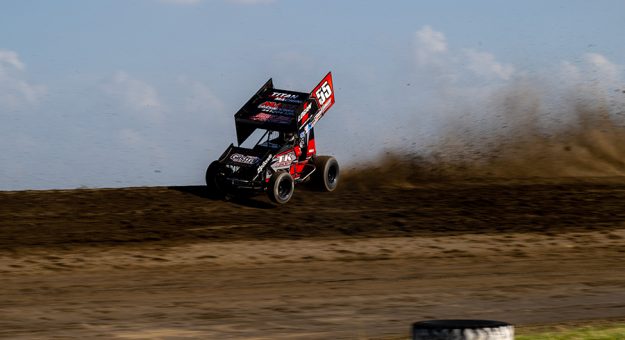Hunter Schuerenberg remembers the scene well. It was the moment when he realized that it’s possible to turn your passion into a paying proposition.
Hunter Schuerenberg remembers the scene well. It was the moment when he realized that it‘s possible to turn your passion into a paying proposition.
It was 2013, and the then 23-year-old aspiring racer found himself without a ride and was struggling to assemble the pieces needed to campaign his own sprint car. He sold his late-model pickup truck to raise money for a spare sprint car and purchased an inexpensive 1986 Chevrolet C-10 pickup for $3,000 to serve as his daily driver.
Schuerenberg had always had a thing for older Chevy trucks. His grandfather, Melvin Belvin, was into vintage cars and trucks and Hunter always shared their strong appeal. He looked at the ‘86 C-10 as something cheap and fun to drive until he was able to buy something newer.

He wheeled into a gas station, where a man approached him and asked if the truck was for sale. Not really, Schuerenberg replied. But the man persisted, and Schuerenberg responded, “OK, I need six grand for it.”
The guy agreed on the spot, making for a tidy $3,000 profit for Schuerenberg.
“That‘s when I realized, ‘Hey, this might be a good little sideline,‘” he recalled.
Nine years later much has changed for Schuerenberg, a native of Sikeston, Mo. He and his young family have relocated to Brownsburg, Ind., and he currently drives the Vermeer Motorsports No. 55 with the All Star Circuit of Champions. He is also an active trader of vintage cars and trucks, and each year handles buying and selling about 40 vehicles.
“I don‘t really specialize in any one thing, but I‘m definitely a Chevy guy,” he said. “My grandpa was a Chevy guy, although he wasn‘t hardcore about it. My deal started with that ‘86 Chevy C-10, and then went on to cars. In my opinion, Chevy has across the board more muscle car and classic car appeal than any other brand. Other brands are up there, too, but I like Chevy because they have something in almost every price range and style.
“After I sold that first truck I bought another and it sold, then another, then another. It kind of mushroomed. I really like dealing with Tri-Five (1955, ‘56, ‘57) Chevy cars. I liked the vintage stuff my grandpa had, but I had never dug into things deep enough to research them. I didn‘t know much other than I liked them. As I learned more and learned the history, that‘s how everything developed.”

The vintage trade has been an educational process for Schuerenberg. Like any form of commerce, the trader has to develop a keen eye on what is valuable, what a vehicle is worth, and what type of vehicle his potential customers are looking for.
Over time he began to understand how to look objectively at a vehicle and recognize the factors that are crucial to establishing what it is really worth.
“A good friend of mine, Leonard Allen, taught me a lot about how to look at a car and assess what it is,” he says. “Everybody is a little different in how they do this, but I have a preference to stick with vehicles I personally like and enjoy. I like stuff that has an original feel. Certain things will go in and out of style; there for a while chrome all over the engine was in style, 24-inch wheels were in style, black wheels were in style…but I still like to go back to the original look and feel, what they call ‘period correct.‘
“Period correct never goes out of style. You can do some tasteful modifications, but not too much. That‘s the look I prefer. My feelings are that if it‘s a vehicle I like, somebody else will like it, too.”
Schuerenberg prefers to deal with vehicles that need very little work. A “basket case” is too much work and too much money, he says. Restoring a vintage car or truck today can easily run into tens of thousands of dollars, often much more than the finished vehicle is worth.
At this writing Schuerenberg is in possession of a 1956 Chevrolet Delray sedan, a 1971 Chevrolet C-10 pickup and a 1967 Chevrolet Chevy II. He is always on the lookout for the right car.
“It started out with scouring Facebook and other websites for hours,” he said. “That‘s still some of it, but I‘ve developed enough contacts that I get calls with something somebody heard of, something I might be interested in. So it‘s a little bit researching, a little bit word-of-mouth.”
When Schuerenberg spots a car of interest, he‘ll get a feel for what the car is worth on the retail market. If the price is right, he‘ll buy the car and make arrangements to get it back to his shop in Brownsburg. After some detail work and any repairs or minor modifications he feels the car needs, he‘ll promote the car on his social media accounts and on specialized pages related to that type of car.
“One thing you learn is to be reasonable with your pricing,” he said. “Don‘t try to score a home run on one car. You‘ll buy and sell a lot of cars with other dealers like you, and if you‘re selling a car to another dealer you have to leave him some room to make some money. If you do that, guys will be more likely to want to trade with you in the future.”
